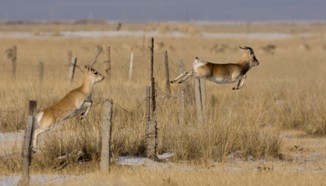Ge Yuxiu, a wildlife photographer hiding behind a bush, aims his camera at five lively Przewalskii gazelles to capture the plateau ballerinas' graceful dance.
 |
|
File photo: Przewalskii gazelles |
It is all peaceful, but a barbed wire fence spoils the perfect shot. Ge begins to worry. He knows they are not good hurdlers.
For Przewalskii gazelles, a rare species native only to China's northwest Qinghai Province now, fence-crossing was often a matter of life and death. Many of them were seriously injured or even killed trying to do so.
Occasionally, some could be seen hanging off the fences, dead from excessive bleeding or suffocation. And Ge took pictures of them.
"Although it hurts me every time, I feel obliged to take the pictures to let more people see the brutality of the fences with their own eyes," said Ge.
Ge, 55, a veteran and an environmentalist, was among the first to call for the protection of the animal. When he took his first picture of them in 1996, only 300 were left in the world, all scattered in the grasslands around the Qinghai Lake.
In the same year, the Przewalskii gazelle was enlisted in the Red List of Threatened Species of International Union for Conservation of Nature (IUCN), the world's largest global environmental network headquartered in Gland, near Geneva, in Switzerland.
Named after Russian explorer who discovered the species first in Inner Mongolia 130 years ago, Przewalskii gazelle used to roam in a broad swath across China's central and western interior, including Inner Mongolia, Ningxia, Gansu, Xinjiang and Qinghai.
Although the number of the species has doubled to around 600 so far after the building of a 495,200-hectare nature reserve in 1997 around the Qinghai Lake, the creature is still among the most vulnerable of hoofed animals. Some claim it is more precious than giant pandas and Tibetan antelopes.
"Local herdsmen use barbed fire fences to protect pasturelands," said Jiang Zhigang, author of Procapra Przewalskii, board member of U.S.-based Wildlife Professionals and a senior researcher of the Chinese Academy of Sciences.
To secure the pastureland for their own livestock, herdsmen erect barbed wire fences, often about 1.5-meter-high, turning the vast grassland into numberless segments.
Some herdsmen even use fire crackers to scare gazelles away.
"While herdsmen and their livestock dominate the land, Przewalskii gazelles have to struggle," said Jiang.
In 2007, Qinghai provincial government invested 200,000 yuan (US$29,280), and donations totaling 140,000 yuan (US$20,496), to set up a watch tower and three drinking pools to make the gazelles' life easier in the reserve.
"But that's only the beginning and far from enough." said Ge. Przewalskii gazelles need a well-managed special reserve of at least 350 hectares. "
Official statistics showed that China had 1,596 giant pandas in 2005.
The government planned to relocate local herdsmen. But lack of funds made the government to give it up, according to Jiang Zhigang.
However, the establishment of a breeding base at the Qinghai-Tibet Plateau Wildlife Preservation and Breeding Center has brought hope for the endangered species.
The breeding base, covering nine hectares, is the home of nine Przewalskii gazelles now.
The next step is to try artificial fertilization, said the center's deputy chief Wang Xiaofei.
"Our job is to take good care of the gazelles and help them return to nature when they grow up," Wang said.
(Xinhua News Agency July 18, 2009)